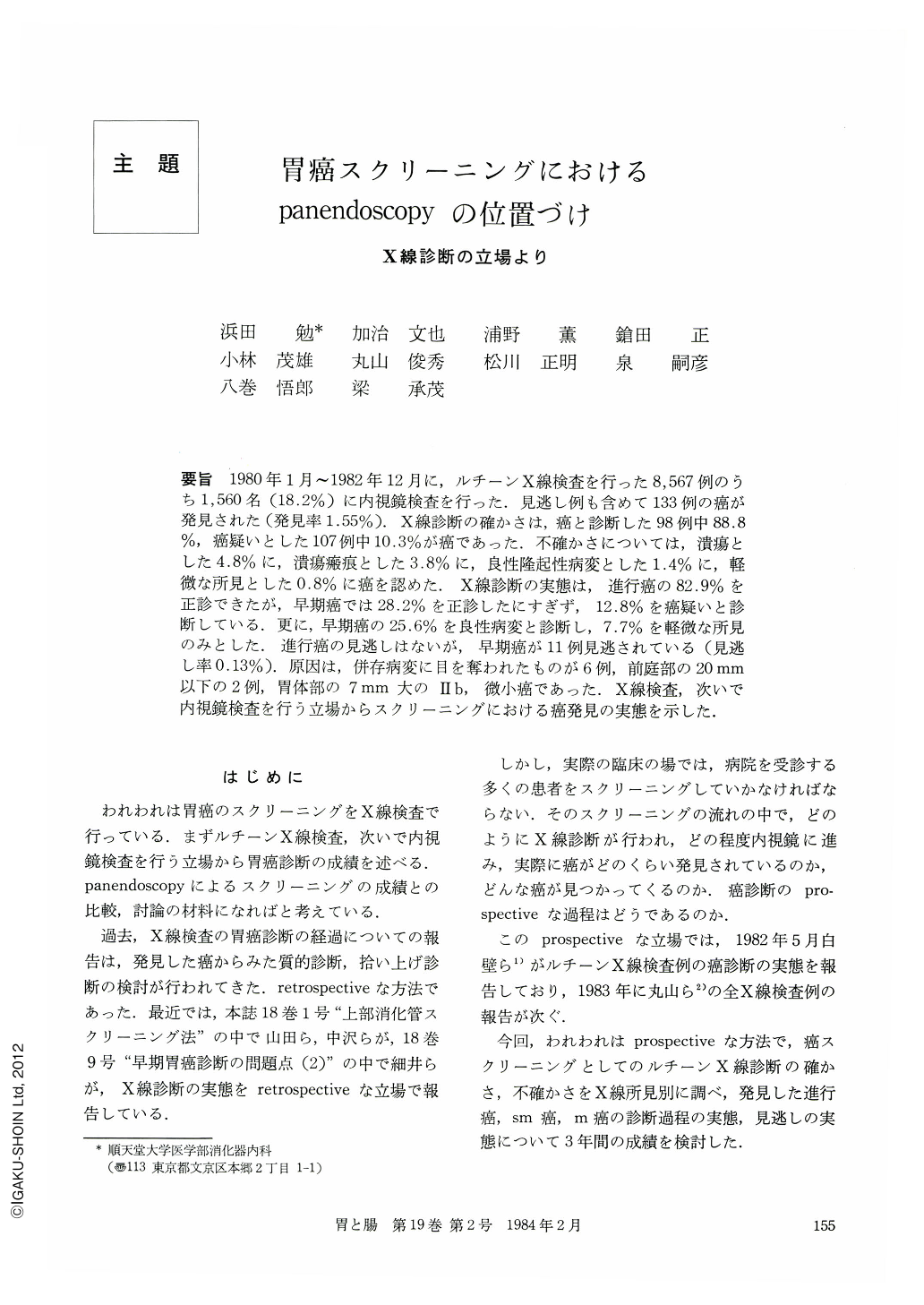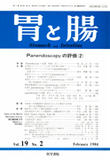Japanese
English
- 有料閲覧
- Abstract 文献概要
- 1ページ目 Look Inside
- サイト内被引用 Cited by
要旨 1980年1月~1982年12月に,ルチーンX線検査を行った8,567例のうち1,560名(18.2%)に内視鏡検査を行った.見逃し例も含めて133例の癌が発見された(発見率1.55%).X線診断の確かさは,癌と診断した98例中88.8%,癌疑いとした107例中10.3%が癌であった.不確かさについては,潰瘍とした4.8%に,潰瘍瘢痕とした3.8%に,良性隆起性病変とした1.4%に,軽微な所見とした0.8%に癌を認めた.X線診断の実態は,進行癌の82.9%を正診できたが,早期癌では28.2%を正診したにすぎず,12.8%を癌疑いと診断している.更に,早期癌の25.6%を良性病変と診断し,7.7%を軽微な所見のみとした.進行癌の見逃しはないが,早期癌が11例見逃されている(見逃し率0.13%).原因は,併存病変に目を奪われたものが6例,前庭部の20mm以下の2例,胃体部の7mm大のⅡb,微小癌であった.X線検査,次いで内視鏡検査を行う立場からスクリーニングにおける癌発見の実態を示した.
A routine radiologic examination of the upper gastrointestinal tract was performed in 8,567 symptomatic patients who came to our department between January, 1980 and December, 1982.
Out of the 8,567 patients, 1,560 were referred to endoscopy and 133 patients were found to have gastric cancer (1.55%). In 88.8% of 98 patients who were diagnosed as having gastric cancer at a routine radiologic examination, endoscopy with biopsy confirmed the diagnosis. Gastric cancer, however, was endoscopically discovered in 10.3% of 107 patients whose radiologic findings were suggestive of gastric cancer. Furthermore, endoscopy detected gastric cancer in 24 patients who were radiologically diagnosed as having a benign gastric lesion or who were referred to endoscopy because of inconclusive vague mucosal abnormality.
82.9% of 69 patients with advanced gastric cancer were correctly diagnosed by a routine radiologic examination, but a correct radiologic diagnosis was made only in 28.2% of 39 patients with early gastric cancer. Radiologic findings were highly suggestive of gastric cancer in 12.8% of the 39 patients with early gastric cancer, and 25.6% of them were radiologically diagnosed as having a benign gastric lesion at a routine examination. In 7.7% of them, a routine examination just visualized inconclusive vague mucosal abnormality.
Gastric cancer was detected in 11 patients who was not, radiologically considered as having any abnormality in the stomach with a radiological false negative rate of 0.13%, and all cancers were early in stage. All attention was paid to other more striking coexistent lesions at both radiography and interpretation, and early gastric cancer was overlooked in six out of the 11 patients. Two early gastric cancers on the posterior wall of the gastric body less than 10 mm in diameter and another three in the gastric antrum less than 20 mm in diameter were poorly visualized at a routine radiologic examination.
Accuracy of a radiologic examination for gastric cancer detection as a screening method was evaluated by the results of subsequently performed endoscopy. Better detectability of gastric cancer was obtained by subsequent endoscopy than by a routine radiologic examination. These results may be one of the conclusions in the comparison of detectability of gastric cancer between a radiologic examination and endoscopy. Evaluation, however, of accuracy of endoscopy for gastric cancer detection as a screening method is required.

Copyright © 1984, Igaku-Shoin Ltd. All rights reserved.


